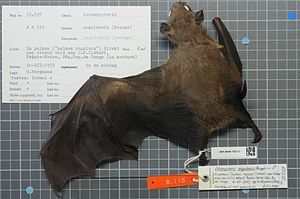Angolan velvet fruit bat
| Angolan velvet fruit bat | ||||||||||||
|---|---|---|---|---|---|---|---|---|---|---|---|---|

Preparation of Lissonycteris angolensis angolensis in the Naturalis Biodiversity Center in Leiden |
||||||||||||
| Systematics | ||||||||||||
|
||||||||||||
| Scientific name of the genus | ||||||||||||
| Lissonycteris | ||||||||||||
| Andersen , 1912 | ||||||||||||
| Scientific name of the species | ||||||||||||
| Lissonycteris angolensis | ||||||||||||
| ( Bocage , 1898) |
The Angolan velvet-fur flying fox ( Lissonycteris angolensis ) is a small species of flying fox that occurs with five subspecies in a large, disjointed range in sub-Saharan Africa.
features
Angolan velvet-fur flying foxes are relatively small and reach a total length (tip of the snout to the end of the tail) of 9 to 14 cm and a wingspan of about 20 cm. The tail is rather short with a length of 8 to 21 mm. The coat is generally dark brown, silky smooth, and dull. It extends down to the upper arms. The head has no white or other light markings. The back hair can be dark red brown, dark golden brown or gray brown. The hair on the head is darker, that on the belly a little lighter and grayer. Males and females are similar in terms of size and color, only on the throat of the males there are coarse hairs that the females lack. The ears are hairless, dark brown and rounded at the tips. The flight skin is dark brown.
Subspecies and distribution
The Angolan velvet-fur flying fox ( Lissonycteris angolensis ) occurs with five subspecies in a large, disjoint distribution area in Africa south of the Sahahra.
- Lissonycteris angolensis angolensis , Angola to southeast Nigeria with a distribution gap in Gabon.
- Lissonycteris angolensis smithii , West Africa west of 2 ° East
- Lissonycteris angolensis ruwenzorii , East Africa
- Lissonycteris angolensis petraea , south of the Ethiopian highlands
- Lissonycteris angolensis goliath , border area between Mozambique and Zimbabwe
Way of life
The animals live in rainforests, mountain forests, gallery forests and forest savannas from sea level to altitudes of 2200 meters. In rainforests they live more at the edge of the forest and the closed interior of the forest is uninhabited by the species. Usually they are only found in areas with fruiting trees and suitable burrows. They fly slowly, are very agile and can therefore fly through dense vegetation. They orientate themselves with their eyes, echolocation is not possible for the animals.
Angolan velvet-skin flying foxes spend the day in caves, mine tunnels, hollow tree trunks or in narrow crevices between large rocks close together. Usually they sleep in groups of 2 to 50, rarely up to 100, and in a few cases alone. They share the shelters sometimes Nilflughunden ( Rousettus aegyptiacus ) Maclauds horseshoe bat ( Hipposideros maclaudi ), the ordinary circular leaf-nosed ( Hipposideros caffer ) and the Cyclops round leaf-nosed ( Hipposideros cyclops ).
The Angolan Velvet Fruit Bat feeds on fruits that it flies directly to, i.e. H. the animals do not land beforehand and crawl over branches to their food. Soft fruits such as figs and the fruits of Anthocleista , Chlorophora , Nightshade and Adenia are preferred , as well as fruits grown by humans, fruits of mangroves and guavas . In contrast to other fruit bats, the Angolan velvet-fur fruit bat has never been observed to seek out flowers. The females have a single young animal per birth.
Systematics
The Angolan velvet-fur fruit bat was first described in 1898 by the Portuguese zoologist José Vicente Barbosa du Bocage as Cynonycteris angolensis , and in 1912 assigned to the monotypical genus Lissonycteris by Andersen . Some scientists believe that the L. a. goliath , L. a. petraea and L. a. smithi represent separate species. The differences between the nominate form and the subspecies could, however, also be a clinical (gradual) change in a biological characteristic parallel to an ecological gradient . In 2007 a specimen was described from Malawi that had both characteristics of L. a. goliath and L. a. ruwenzorii .
literature
- Meredith Happold: Genus Lissonycteris Angolan Soft-furred Fruit Bat, page 262-265 in Meredith Happold and David Happold (eds.): Mammals of Africa Volume IV. Hedgehogs, Shrews and Bats . Bloomsbury, London, 2013, ISBN 978-1-4081-2254-9
